History of rail transport in Great Britain 1995 to date
This article is part of a series on the History of rail transport in Great Britain

The period from 1995 covers the history of rail transport in Great Britain following the privatisation of British Rail. During this period, passenger volumes have grown rapidly,[1] safety has improved,[2][3] and subsidies per journey have fallen. However, there is debate as to whether this is due to privatisation or better government regulation. See Impact of privatisation for more information. During this period, High Speed 1 and the West Coast Main Line upgrade were completed and more construction projects are currently under way.
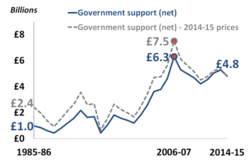
Overall rail subsidies have risen, as shown in the graph, although spend per journey has decreased, with the government providing a net total of £4.8 billion in 2014-15. This is down to increased investment (including £1.1 billion for Crossrail) as the railways now cover 99% of their operating costs, as opposed to making a £2 billion loss in the first full year of rail franchising.[4][5] However, this masks great regional variation, with "funding varying from £1.88 per passenger journey in England, to £7.77 per journey in Scotland, and £9.18 per journey in Wales".[6]
Due to the increase in passenger numbers and the prospect of high speed rail both within Great Britain and connecting to Europe, this period has been called the start of a new Golden Age of rail travel.[7][8] However quickly increasing passenger numbers have meant many trains are very crowded at peak times.[9] Peak-time fares have increased by over 200% (since privatisation) to deter people from travelling at these times,[10] whereas the price of advance tickets has halved in the same period.[11]
Government policy
Reform under the Labour government (1997–2010)

The Labour government (elected in 1997 after the majority of the privatisation process had been completed) did not completely reverse the railway privatisation of the previous administration. Initially it left the new structure largely in place, however its main innovation in the early years was the creation of the Strategic Rail Authority (SRA), initially in shadow form until the Transport Act 2000 received Royal Assent.
In the wake of the Hatfield rail crash in 2000, Railtrack entered into financial meltdown and the industry was in deep crisis. Labour refused to continue to bail out Railtrack and the company was put into Railway Administration in 2001 and a new company, Network Rail emerged to replace Railtrack in 2002. Since September 2014, Network Rail has been classified as a "government body".[13][14]
The Strategic Rail Authority lasted just five years. Following the passing of the Railways Act 2005, its business was wound up and its functions transferred to the Department for Transport Rail Group and the Office for Rail Regulation.[15] Further changes have followed, which has seen the government take back a greater degree of control but the early demise of the SRA suggests that the right formula for the long-term health of the rail industry has not yet been agreed.
Another important development occurred in the aftermath of the Potters Bar accident in May 2002 when a commuter train derailed (coincidentally on the same stretch of the East Coast Main Line as Hatfield) due to poorly maintained points. This resulted in Network Rail taking all track maintenance back in house and the industry went on to enjoy the longest period in modern times without a fatal accident due to industry error. This came to an end in February 2007 when a Virgin Pendolino derailed near Grayrigg in Cumbria, killing one person. The cause of the accident was identical to that in Potters Bar nearly five years earlier – once again calling into question Network Rail's maintenance procedures.
Following Gordon Brown's appointment as Prime Minister in 2007, Andrew Adonis was appointed Transport Secretary. He immediately began work on plans for a new high-speed route between London and Birmingham (later known as High Speed 2), which would augment the West Coast Main Line. Adonis also announced plans to electrify the Great Western Main Line from London as far as Swansea, as well as infill electrification schemes in the North West of England to remove diesel traction from certain key routes. Late in 2009, the InterCity East Coast franchise collapsed for the second time in three years when incumbent operator National Express East Coast (NXEC) proved unable to meet its financial obligations. Adonis transferred the franchise to the state-owned Directly Operated Railways to operate the route under its East Coast subsidiary.
Reform under the Coalition government (2010–2015)
After the 2010 General Election, the new Conservative led Coalition continued Labour's rail policies largely unaltered after a pause to review the finances. There was continuing support for the High Speed 2 scheme and further developing plans for the route, although great debate still rages over the scheme's benefits and costs. Whilst initially showing scepticism towards the electrification schemes of the Great Western route, they later gave the project its backing and work began formally in 2012. Plans were also mooted to electrify the remainder of the Midland Main Line.
In 2012, the franchising system again came under criticism when FirstGroup successfully ousted Virgin Trains as operator of the InterCity West Coast franchise. Virgin initially pursued a judicial review against the decision, citing the fact that First's bid was even more ambitious than the one which had scuttled National Express East Coast less than three years earlier. Before the review took place however, newly installed Transport Secretary Patrick McLoughlin scrapped the entire bidding process for the franchise and granted Virgin an extension to its contract when "severe technical flaws" were discovered in the original bidding competition.
The Conservative government (2015–present)

The Government has moved towards allowing more competition on the intercity network through open access operators. In 2015 it approved a service run by Alliance Rail to operate between London and Blackpool, and both Alliance and FirstGroup have applied to run open access services on the East Coast Main Line.[16][17]
Much debate continues over annual fare increases, although the government has now pledged to keep regulated rail fare increases at Retail Prices Index (RPI) inflation for the remainder of this Parliament.[18] In addition much debate has continued over the financing of various rail schemes driven primarily by the huge cost and time overrun on the GWML route modernisation and electrification scheme. In connection with this, and to coincide with the Chancellor's Autumn statement on 25 November 2015, the Bowe and Hendy reports were produced.[19][20]
In March 2016, the National Infrastructure Commission said that Crossrail 2 should be taken forward "as a priority" and recommended that a bill should pass through Parliament by 2019 and the line should be open by 2033.[21] Crossrail 2 is a North-South railway through London, similar to the East-West railway Crossrail which is currently under construction.
Infrastructure projects
Completed projects
The British railway system continues to be developed. Contemporary projects include:
- The West Coast Main Line upgrade was a long-term project covering a series of technical aspects. Improvements included the four-tracking (from three) of the Trent Valley (a bypass of the West Midlands), redesigning the layout of several junction/stations e.g. Rugby and other associated work to increase line speed. This culminated in tilting trains at 125 mph being extended to Glasgow in 2005. The cost overruns of the programme are infamous - attributed to wide scope of programme (the promise to Virgin to build a 140 mph railway which would require moving block signalling) and poor project management by the defunct Railtrack.
England
- High Speed 1, a project to construct a 67-mile high-speed rail line from London to the British end of the Channel Tunnel, and involving a great deal of complex civil engineering including a 1404-yard bridge over the River Medway, a 2-mile tunnel under the Thames near Dartford, a 2-mile tunnel through the North Downs, 12-mile twin tunnels running into central London, a major new railway station extension to St Pancras Station in London, and a complex redesign and rebuild of the King's Cross St Pancras tube station. The southern phase 1 of the project opened in September 2003, and northern phase 2 opened in November 2007.
- The electrification of the Liverpool to Manchester line was completed in 2015 and electric Class 319 trains (on the Liverpool to Manchester Airport service) and Class 350s (on the Manchester Airport to Scotland services) have replaced diesel units.
Scotland
- The Stirling-Alloa-Kincardine railway, a rare 13 mile (21 km) extension to the network, to the north of the Firth of Forth in Scotland. A Bill for the railway was passed by the Scottish Parliament and received Royal Assent in August 2004. Work commenced in September 2005, with services running by early 2008. The line re-establishes a railway decommissioned in 1983; the new line provided passenger connections to Glasgow, and freight links between the site of Kincardine power station, now used as a loading point for coal from open-cast sites, to avoid heavy traffic through Kincardine, and Longannet power station, and the coal terminals at Hunterston Deep Water Port. Longannet power station closed in 2016. The passenger part of the scheme, from Stirling to Alloa was in any case secure, and the Scottish Parliament appear to be in favour of passenger services being extended to Rosyth. This could possibly result in passenger stations serving the communities of Clackmannan, Kincardine, and Culross or Valleyfield, and through trains once more from Stirling to Dunfermline.
- A short extension of the Glasgow-Hamilton-Motherwell, which once again links Larkhall to the railway network after 40 years. Larkhall has for some time been the largest town in Scotland without a railway station. The new £35m line follows an existing formation, and services to Larkhall railway station resumed on 12 December 2005.[22] The new section of route is electrified and is served with trains from Dalmuir, via Glasgow Central Low Level, with connections from other northern suburbs of Glasgow such as Milngavie.
- The Airdrie-Bathgate Rail Link was completed in December 2010, work having started in June 2007. The Airdrie-Bathgate project was quite extensive insofar as it included double track electrification, the present remnant of the line from just outside Edinburgh to Bathgate having been largely singled some time ago.
- The Glasgow Airport Rail Link was given the go ahead by the Scottish Parliament in December 2006 but the project was scrapped by the new SNP minority government in September 2009. A new 1.5 mile spur was to be built onto the existing Inverclyde route. An element of the project that did go ahead was upgrading the Glasgow Central - Paisley line to triple track to increase capacity on the Ayrshire and Inverclyde routes. This work was completed in 2012.
- A 35-mile section of the Waverley Route from Edinburgh to Tweedbank in the Scottish Borders has been rebuilt after approval by the Scottish Parliament, which reopened on 6 September 2015. This project, also known as the Borders Railway, restored rail services to communities which have lacked access to the National Rail network since the Beeching cuts.
Wales
- The Welsh Assembly Government re-opened the Vale of Glamorgan Line between Barry and Bridgend in 2005 and the Ebbw Valley Railway between Ebbw Vale Parkway and Cardiff Central in 2008. An extension of the line to Ebbw Vale Town opened in 2015.
Current developments
- High Speed 2 (HS2) is a planned[23][24] high-speed railway which will initially link the cities of London and Birmingham, followed by further extension to North West England and Yorkshire. Construction of the first phase of HS2 is set to begin in 2017 with an indicated opening date of 2026, while completion of the entire network is expected in 2033. Phase one of HS2 will run between London Euston and the proposed new Birmingham Curzon Street station. Phase two will create two branches: a western section to Manchester Piccadilly, and an eastern section to the proposed Leeds New Lane station via the East Midlands Hub (serving Derby, Nottingham and Leicester) and Meadowhall Interchange (serving Sheffield).
- The Thameslink Programme, formerly known as 'Thameslink 2000' is underway as the government formally approves the project. The project includes the lengthening of platforms, station remodelling, new railway infrastructure (e.g. viaducts) and additional rolling stock, which will allow First Capital Connect to expand their Thameslink services further north and south.
- The Northern Hub is a rail project across Northern England aimed at stimulating economic growth by increasing train services, reducing journey times and electrifying lines between the major cities and towns in the north.[25] The project was announced as the Manchester Hub, entailing a series of upgrades to cut journey times between cities in Northern England by alleviating rail bottlenecks around Manchester.[26][27] Central to the project is the resolution of rail bottlenecks around Manchester city centre allowing more capacity and faster journey times between the northern cities. The construction of two through platforms at Piccadilly will allow an increase to 14 trains per hour from 10. Manchester Victoria station is being modernised to become the east-west rail interchange in northern England. Trains from the north east to Manchester Airport will use a new section of railway, the £85 million Ordsall Chord, between Manchester Victoria and Manchester Oxford Road to access Manchester Piccadilly and continue to the airport without the need to reverse at Piccadilly and without conflicting movements at the station throat. Services from Liverpool to Leeds and beyond will be diverted from the Cheshire Lines route via Warrington Central and Manchester Piccadilly to the electrified line via Newton-le-Willows and Manchester Victoria.
- On the Great Western Main Line, Network Rail plans to spend £5 billion[28] on modernising the GWML and its South Wales branch plus other associated lines like the North Cotswolds[29] which was completed in 2011. The modernisation plans were announced at separate times but their development time-scales overlap each other to represent a comprehensive modernisation plan for the Great Western and its associated lines during the second decade of the 21st century. The modernisation includes: electrification, resignalling, new rolling stock and station upgrades. According to Network Rail, the modernisation started in June 2010 and will end in 2017.[30] On 8 November 2016 the government announced that several elements of the Great Western Main Line electrification programme would be indefinitely deferred due to cost overruns and delays.[31][32]
- Crossrail is a 118-kilometre (73-mile) railway line under construction in London and its environs. It is expected to begin full operation in 2019 with a new east-west route across Greater London. Work began in 2009 on the central section of the line—a new tunnel through central London—and connections to existing lines that will become part of Crossrail.[33] Crossrail's aim is to provide a high-frequency commuter/suburban passenger service that will link parts of Berkshire and Buckinghamshire, via central London, to Essex and South East London.
- Scotland
- The Edinburgh to Glasgow Improvement Programme or "EGIP" is an initiative started by the Scottish Government to upgrade the main railway line between Edinburgh and Glasgow via Falkirk High by 2016. The route via Shotts will follow in 2017. It is expected to cost around £650 million.
- Wales
- The Welsh Assembly Government proposes to extend the line between Ebbw Vale and Cardiff into Newport in the future. The Assembly Government is also looking into opening the Hirwaun to Aberdare route in the Cynon Valley.
Timeline of improvements
2016
- February: The first of 27 Class 387/2 Electrostar units were introduced on the Gatwick Express route between London Victoria and Gatwick Airport, replacing the Class 442s.[34]
- March: The Norton Bridge flyover on the West Coast Main Line was brought into use.[35]
- June: The first of 115 Class 700 Desiro City units entered service on Thameslink.[36]
- July: The new Bromsgrove station opened.[37]
- 12 December: The western section of the East West Rail Link is scheduled for completion, which will extend the line from Oxford Parkway to Oxford.[38]
- December: The Edinburgh to Glasgow Improvement Programme is scheduled for completion, allowing new Class 385 trains to run in 2017.[39]
2017
- May: The first of 66 Class 345 Aventra units are scheduled to enter service on Crossrail. These will replace the 44 TfL Rail Class 315 units that presently operate this service.[40]
- June: Electrification of the Gospel Oak to Barking Line is scheduled for completion.[41] [42]
- June: The first of 30 Class 707 Desiro City units are scheduled to enter service with South West Trains.[43]
- July: The first Class 800 Super Express and Class 801 Super Express trains are scheduled to be introduced on the Great Western Main Line.[44][45]
- December: Preston to Manchester electrification is scheduled for completion.[46]
- December: Electrification of the Chase Line to Walsall is scheduled for completion.[47]
- December: Construction of the Ordsall Chord is scheduled for completion.[48]
- Lostock Junction to Wigan electrification is scheduled for completion of GRIP 3.
- Electrification of Windermere Branch Line is scheduled for GRIP 3 completion.[49]
- Electrification of the Cross-City Line to Bromsgrove is scheduled for completion.[37]
- Redoubling of track from Rossett to Chester on the Shrewsbury to Chester Line is scheduled for completion.[50]
2018
.jpg)
- February: Preston to Blackpool North electrification is scheduled for completion.[51]
- May: Services between Paddington and Heathrow Terminal 4 as well as Heathrow Central and Heathrow Terminal 4 will transfer from Heathrow Express to Crossrail.[52]
- May: The first of 45 Class 710 Aventra units are scheduled to enter service for London Overground on the Lea Valley Lines, Gospel Oak to Barking Line, Watford DC Line and the Romford to Upminster Line.[53]
- May: Resignalling on the Halton Curve that will allow trains to travel in both directions (presently trains can only travel on the line in a northbound direction) from Chester to Liverpool Lime Street (via Runcorn) is scheduled for completion.[54]
- December: The central section of Crossrail (Paddington to Abbey Wood) will open.[52]
- December: Electrification of the Great Western Main Line from London to Cardiff is scheduled for completion.[55]
- ERTMS (in-cab signalling) will be introduced on sections of the Great Western Mainline and the East Coast Main Line.
- The Thameslink Programme is scheduled for completion.[55]
- The first Class 800 Super Express and Class 801 Super Express trains are scheduled to be introduced on the East Coast Main Line.[44]
- The first Class 195 Civity and Class 331 Civity units are scheduled to start running services on Northern's network.[56]
- The first of twelve 5-car Class 397 Civity trains are due to enter service for TransPennine Express.[57]
2019
- May: Services between Paddington and Shenfield will commence on Crossrail.[52]
- June: Electrification of the Oxford branch of the Great Western Main Line was scheduled for completion. However on 8 November 2016 the government announced that electrification of this branch would be indefinitely deferred due to cost overruns and delays on the overall project.[31]
- December: The Crossrail network will be complete with the transfer of services between Paddington and Reading from Great Western Railway to Crossrail.[52]
- December: All of the Pacer (Class 142, Class 143 and Class 144) units must be withdrawn from service by the end of December 2019. However Porterbrook have proposed a refurbishment of their Class 143 and Class 144 units that would bring them within compliance of the Disability Discrimination Act of 2005. This refurbishment would allow them to remain in service until 2032.[58]
- Electrification of the Midland Main Line to Corby is scheduled for completion.[59]
2020
- The Croxley Rail Link is scheduled for completion and opening.[60]
2022
2023
- Electrification of the Midland Main Line to Leicester, Derby/Nottingham and Sheffield is scheduled for completion.[59]
Present locomotives and rolling stock
Diesel locomotives
* BR Class 73 is an electro-diesel locomotive which allows electrified and non electrified route workings.
Electric locomotives
| Image | Class | Operator(s) | Image | Class | Operator(s) |
|---|---|---|---|---|---|
| 86 | 90 | ||||
 |
91 | 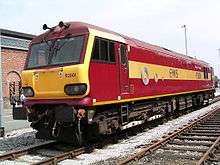 |
92 | ||
 |
73a |  |
Eurotunnel Class 9 |
a BR Class 73 is an electro-diesel locomotive which allows electrified and non electrified route workings.
Diesel multiple units
| Image | Class | Operator(s) | Image | Class | Operator(s) |
|---|---|---|---|---|---|
 |
|
150 | |||
 |
153 |  |
155 | ||
| 156 | 158 |
| |||
 |
|
170 |
| ||
 |
175 | 180 | |||
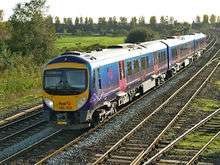 |
185 |  |
|
AC electric multiple units
| Image | Class | Operator(s) | Image | Class | Operator(s) |
|---|---|---|---|---|---|
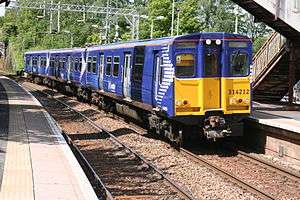 |
|
| |||
|
323 | ||||
|
 |
334 | |||
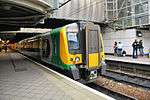 |
350/2 | 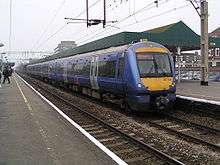 |
357 | ||
 |
360 | 365 | |||
.jpg) |
373 |
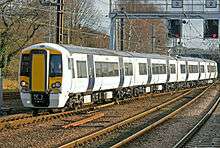 |
|||
 |
380 |  |
387 | ||
| 390 |
Dual AC/DC electric multiple units
| Image | Class | Operator(s) | Image | Class | Operator(s) |
|---|---|---|---|---|---|
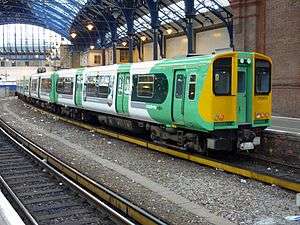 |
319 | ||||
| 700 | |||||
 |
325 | 350/1 | |||
|
395 |
DC electric multiple units
| Image | Class | Operator(s) | Image | Class | Operator(s) |
|---|---|---|---|---|---|
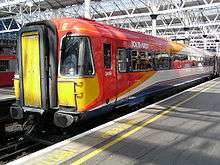 |
442 | .jpg) |
|||
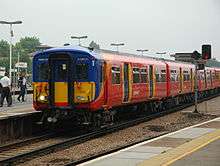 |
455 |  |
456 | ||
| 458 | 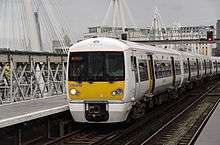 |
376 | |||
 |
 |
Coaches
| Image | Model | Operator(s) | Image | Model | Operator(s) |
|---|---|---|---|---|---|
| BR Mk II |
|
 |
BR Mk III |
| |
 |
BR Mk IV | BR Mk III Sleeper |
Details of withdrawn locomotives and rolling stock : See article Withdrawn British Rail stock
Future rolling stock
| Image | Class | Operator(s) | Type | Image | Class | Operator(s) | Type |
|---|---|---|---|---|---|---|---|
.jpg) |
88 | Direct Rail Services | Bimode |  |
70 | Colas Rail | Diesel |
| 195 | DMU | 331 | EMU | ||||
| 345 | EMU | 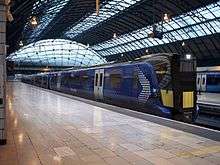 |
385 | EMU | |||
|
EMU |  |
800 |
Bimode (800, 802) EMU (801) |
References
- Wolmar, Christian (2005). On the Wrong Line: How Ideology and Incompetence Wrecked Britain's Railways (rev. ed.). London: Aurum Press. ISBN 1-85410-998-7.
- ↑ "Growth of 6.9% in 2010 takes demand for rail travel to new high levels". Association of Train Operating Companies. February 2011. Archived from the original on 25 February 2015. Retrieved 25 February 2015.
- ↑ "NATIONAL RAIL TRENDS 2009-10 YEARBOOK" (PDF). Retrieved 21 February 2011.
- ↑ "Railway safety statistical report 2007" (PDF). Retrieved 21 February 2011.
- ↑ Office of Rail Regulation: 2014-15 Annual Statistical Release Rail Finance
- ↑ "Dataset on industry finances and performance 1997-98 – 2013-14" (PDF).
- ↑ "Rail regulator publishes industry financials report for 2013-14 | Office of Rail and Road". Orr.gov.uk. Retrieved 2016-06-03.
- ↑ Beanland, Christopher (10 July 2014). "Striking new stations, high-speed links and (whisper it) better services - the UK's railways are entering a new golden age". The Independent. London.
- ↑ http://www.theguardian.com/sainsburys-bank-future-families/2015/jun/19/the-second-golden-age-of-rail-new-fast-trains-will-soon-offer-a-genuine-alternative-to-air-travel
- ↑ Massey, Ray (10 September 2014). "Cattle truck UK: More than half of train passengers forced to stand". Daily Mail. London.
- ↑ Have train fares gone up or down since British Rail?, BBC News, 22 January 2013
- ↑ "The facts about rail fares - Stagecoach Group". Stagecoach.com. 2013-12-06. Retrieved 2016-06-03.
- ↑ "Rail modal share 1952–2014".
- ↑ Stewart, Heather. "Network Rail to be 'government body', adding £30bn to UK national debt". The Guardian. Retrieved 22 December 2013.
- ↑ ONS decision on the classification of Network Rail Department for Transport 17 December 2013
- ↑ "Department for Transport – GOV.UK". Dft.gov.uk. Retrieved 2016-06-03.
- ↑ "London – Blackpool open access service approved".
- ↑ "ORR to decide on Alliance Rail open access application this summer".
- ↑ "Earnings outstrip rail fare increases for first time in a decade".
- ↑ "Bowe Report".
- ↑ "Hendy Report".
- ↑ "Crossrail 2 must be developed 'as a priority' and delivered by 2033 – NIC".
- ↑ "Glasgow - News, views, gossip, pictures, video - Daily Record". Iclanarkshire.icnetwork.co.uk. Retrieved 2016-06-03.
- ↑ "HS2: Phase one of high-speed rail line gets go-ahead". BBC News. 10 January 2012.
- ↑ "Go-ahead given to new railway". Department for Transport. January 2012.
- ↑ "Northern Hub". Northern Hub. Retrieved 27 December 2013.
- ↑ "Northern Hub Technical Study" (PDF). Retrieved 13 April 2013.
- ↑ "The Northern Way - Manchester Hub Phase 1" (PDF). Northern Way. April 2009. Retrieved 16 February 2013.
- ↑ "Modernising the Great Western (page 8)" (PDF). Network Rail.
- ↑ "Modernising the Great Western (page 7)" (PDF). Network Rail.
- ↑ "Modernising the Great Western (page 13 timeline)" (PDF). Network Rail.
- 1 2 "Great Western electrification: Intercity line work 'deferred'". BBC News. 8 November 2016. Retrieved 10 November 2016.
- ↑ Paul Maynard (8 November 2016). "Written statement to Parliament, Rail update: rail investment in the Great Western route". gov.uk. Retrieved 8 November 2016.
- ↑ Thomas, Nathalie (26 August 2013). "Going underground on Crossrail: A 40-year project is taking shape". The Telegraph. London.
- ↑ "Late-February debut for Gatwick Express Class 387/2s".
- ↑ https://www.networkrail.co.uk/news/2016/mar/upgrade-improves-railway-Norton-Bridge-opens/
- ↑ Our Commitments : Thameslink
- 1 2 "Bromsgrove's new railway station on track to open in the spring".
- ↑ "NR lays down Oxford tracks ahead of London Marylebone service in December".
- ↑ "EGIP - Electrification Programme". Egip.info. Retrieved 2016-06-03.
- ↑ "Crossrail: New trains".
- ↑ "TfL tries to reduce line-closure time for GOBLIN electrification". 2 February 2016.
- ↑ http://www.networkrail.co.uk/Enhancements-Delivery-Plan-Sept-2016.pdf
- ↑ "First South West Trains Class 707 EMU under construction". Railway Gazette. 29 October 2015. Retrieved 29 October 2015.
- 1 2 Government gives green light for more state-of-the-art intercity trains, Department for Transport, 18 July 2013
- ↑ "GWR runs first bi-mode IEP Class 800 to Paddington".
- ↑ https://www.greatermanchester-ca.gov.uk/download/meetings/id/461/item_14
- ↑ "Walsall to Rugeley electrification – The Chase Line".
- ↑ "Hendy Report January 2016" (PDF).
- ↑ "Windermere branch electrification funding confirmed".
- ↑ http://www.bbc.co.uk/news/uk-wales-north-east-wales-37035905
- ↑ https://www.networkrail.co.uk/North_West_electrification.aspx
- 1 2 3 4 "Crossrail opening timeline".
- ↑ "Bombardier wins London Overground EMU contract".
- ↑ Fuller, Mike (2016-03-21). "Direct trains from Frodsham and Helsby to Liverpool proposed after Halton Curve reopens". Chester Chronicle. Retrieved 2016-06-03.
- 1 2 "GWML electrification dates revealed", www.railtechnologymagazine.com, 22 January 2016
- ↑ "Arriva signs rolling stock contract for new Northern rail franchise". Arriva Rail North. Arriva Rail North. Retrieved 22 March 2016.
- ↑ Haigh, Philip. "Is it time for the railway to standardise on fewer types of trains, to cut costs?". PressReader.com. Rail Magazine. Retrieved 23 July 2016.
- ↑ "Pacers: The train that the UK has struggled to get rid of".
- 1 2 "Midland Main Line improvement programme".
- ↑ Knowles, Michael (30 July 2015). "Croxley Rail Link will not be completed until 2020, documents reveal". Watford Observer. Retrieved 1 December 2015.
- ↑ "Trans-Pennine and Midland Main Line electrification by 2023 as work unpaused".
External links
| Wikimedia Commons has media related to Rail transport in the United Kingdom. |

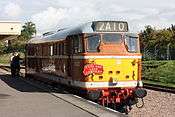


.jpg)
.jpg)
.jpg)
.jpg)
.jpg)
.jpg)


.jpg)